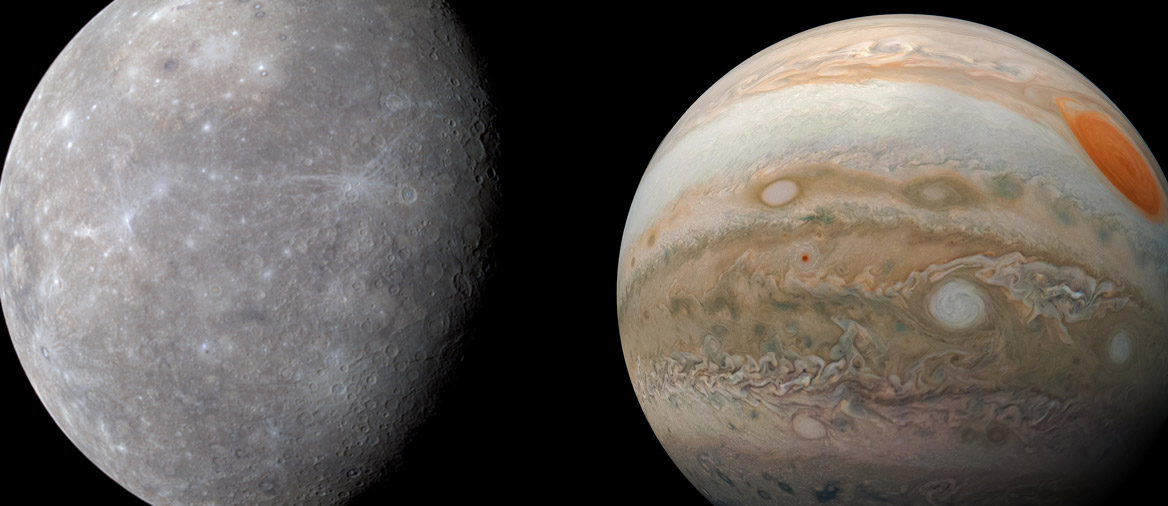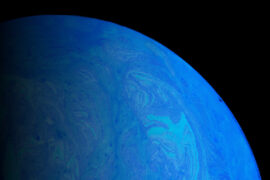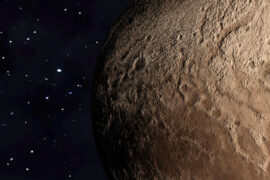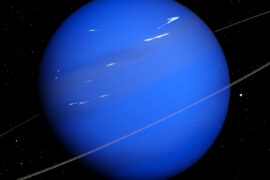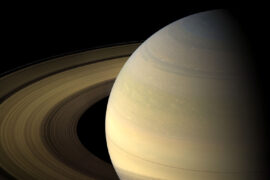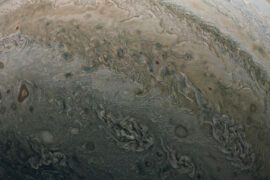Comparing Mercury and Jupiter is a very interesting exercise because, at first glance, they are complete opposites. Mercury is the smallest planet in the Solar system, while Jupiter is the biggest. Mercury is solid, and Jupiter is a gas giant. Mercury has no moons, Jupiter has dozens of them.
It is very likely that Mercury and Jupiter are the planets that are the most different to each other in the Solar system. And yet, as we will learn, even two planets that are so different can still share some things in common that might surprise you, including their origin.
In this article, we will take a look at the differences and similarities between Mercury and Jupiter so we can learn more about both of these intriguing planets.
Mercury vs Jupiter comparison
| Mercury | Jupiter | |
|---|---|---|
| Position in the Solar system | 1 | 5 |
| Distance from the Sun (avg) | 58 million km | 741 million km |
| Radius | 2,440 km | 69,900 km |
| Mass | 3.3 × 1023 kg | 1.9 × 1027 kg |
| Rotation period (1 day) | 59 days | 10 hours |
| Rotation speed | 10.8 km/h | 45,000 km/h |
| Orbit period (1 year) | 87.9 days | 11.85 years |
| Orbital speed | 47.36 km/s | 13.07 km/s |
| Surface temperature (avg) | 164 °C | −110 °C |
| Surface pressure | almost zero (< 0.5 nPa) | 200 – 600 kPa |
| Surface gravity | 3.7 m/s2 | 24.79 m/s2 |
| Density | 5.43 g/cm3 | 1.33 g/cm3 |
| Escape Velocity | 4.25 km/s | 59.5 km/s |
| Albedo | 0.088 | 0.5 |
| Satellites (Moons) | 0 | 95 |
| Core | rock | rock, metal, ice |
| Atmosphere | 42% O, 29% Na, 22% H, 6% He | 89% H, 10% He, 0.3% CH4, traces of others |
Mercury vs Jupiter size comparison
The size difference between Mercury and Jupiter is enormous. Mercury is the smallest planet with a diameter of just 4880 kilometers (3,032 miles) which is just a little bit longer than the width of the continental United States. On the other hand, Jupiter is the biggest planet with a diameter of 139,800 kilometers (86,870 miles) which is 31 times the width of the US.
This means that in terms of volume, you could fit more than 24,000 planets the size of Mercury in just one Jupiter.
The following image shows a scaled comparison of the size difference between both planets.
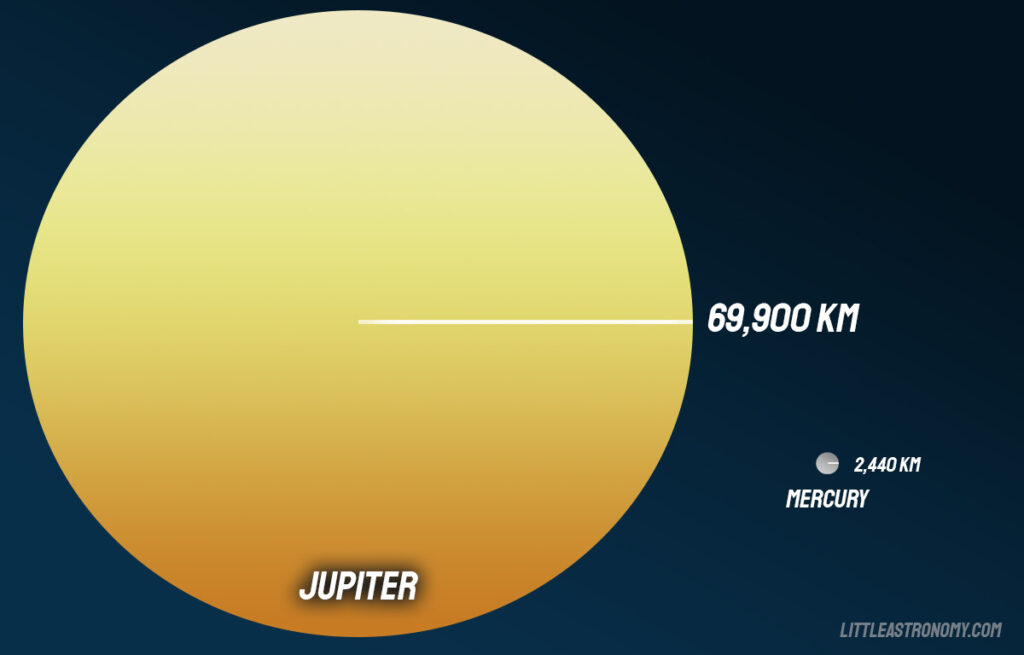
Mercury and Jupiter similarities
- Both planets orbit the same star, the Sun
- Both planets are spherical despite their different composition
- Mercury and Jupiter formed at the same time, about 4.5 billion years ago
- The atmosphere of both planets has a high concentration of hydrogen and helium.
- The core of Mercury and Jupiter are large and make up a big percentage of the planets. Jupiter’s core makes up almost 80% of it and Mercury’s almost 60%. For comparison, Earth’s core only accounts for 17% of the planet’s mass.
- Both planets were known to ancient civilizations so we don’t know who discovered them or named them.
- Both planets are named after Roman mythological gods. Mercury is named after the god of travel, and Jupiter after the god of thunder.
- Mercury and Jupiter rotate in the same direction (counter-clockwise).
- Both planets are located outside the habitable zone of the Solar system.
- Neither planet has oceans or continents.
- Both planets have a magnetic field and magnetosphere. As a matter of fact, Jupiter has the biggest magnetic field of all the planets in the Solar system.
Mercury and Jupiter differences
- Jupiter is much larger than Mercury are very different in size. Mercury is the smallest planet in the Solar system, and Jupiter is the biggest. You could fit Mercury more than 24,000 times in Jupiter.
- Mercury is very hot due to being so close to the Sun. Jupiter is much colder with average temperatures of −185 °C.
- Jupiter’s outer layers are made out of gas and it has no surface. Mercury does have a solid, rocky surface.
- Mercury rotates slowly for its size. Jupiter, despite being so big, is also the planet that rotates the fastest in the Solar system.
- On the other hand, Jupiter travels very slowly through space at just 13 km/h (8 mph). Mercury is much faster at 47.3 km/h (29.3 mph). For comparison, Earth is between both of them at 29.7 km/h (18.4 mph)
- Mercury is a very dense planet (second only to Earth). Jupiter is one of the least dense planets.
- Jupiter has lots of colors (yellow, white, orange, brown) as a result of the different kinds of clouds it has. Mercury is mostly grey.
- Mercury has no moons because it is too close to the Sun. Jupiter currently has 95 moons, making it the second planet with the highest number of natural satellites (Saturn is first).
- Jupiter’s gravity is almost 8 times higher than Mercury’s.
- Jupiter looks brighter than Mercury because it is more reflective. Mercury barely reflects any of the light it gets from the Sun because of its thin atmosphere.
- Jupiter has rings like Saturn, but they are much thinner and less prominent. They can’t even be seen from Earth, but they are there. Mercury doesn’t have any rings.
- Jupiter is almost 13 times farther away from the Sun than Mercury.
- Jupiter has many storms at all times, including its “great red spot”, a storm that has been going on for centuries and is visible from Earth. Mercury doesn’t really have weather like rain or storms because of its weak atmosphere.
Summary
- Mercury and Jupiter are the most different planets in the Solar system in relation to each other.
- Mercury and Jupiter do have some similarities, for example, their age and large cores.
- They are opposites in almost every other way, like size, orbital speed, rotational speed, composition, etcetera.

